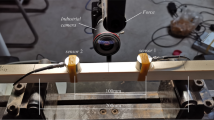Summary
Acoustic emission (AE) signals were collected during fracture tests in order to analyze them for characteristics that could be used as parameters in a reactive control system for the wood drying process. Ponderosa pine and California black oak single edge notch tensile specimens were tested in the TR, TL, and mixed mode configurations, at 12 and 18 percent moisture content and at temperatures of 20, 40 and 60 °C. AE was observed in both opening mode and mixed mode tests, but cumulative events to maximum load in mixed mode were 7.4 times greater than in opening mode for oak and 3.4 times greater in pine. It was concluded that mixed mode AE signals were most promising for pattern recognition analysis, which will be the subject of Part II of this study.
Similar content being viewed by others
References
Booker, J. D. 1994a. Acoustic emission and surface checking in Eucalyptus regnans boards during drying. Holz Roh-Werkstoff 52(6): 383–388
Booker, J. D. 1994b. Acoustic emission related to instantaneous strain in Tasmanian eucalypt timber during seasoning. Wood Sci. Techn. 28(4): 249–259
DeBaise, G. R., Porter, A. W., Pentoney, R. E. 1966. Morphology and mechanics of wood fracture. Materials Res. Stds. 6(10): 493–499
Honeycutt, R. M., Skaar, C., Simpson W. T. 1985. Use of acoustic emissions to control drying rate of red oak. Forest Prod. J. 35(1): 48–50
Kagawa, Y., Noguchi, M., Katagiri, J. 1980. Detection of acoustic emissions in the process of timber drying. Acoustics Letters 3(8): 150–153
Noguchi, M., Kagawa, Y., Katagiri, J. 1980. Detection of acoustic emissions during hardwoods drying. Mokuzai Gakkaishi 26(9): 637–638
Noguchi, M., Kitayama, S., Satoyoshi, K., Umetsu, J. 1987. Feedback control for drying Zelkova serrata using in-process acoustic emission monitoring. Forest Prod. J. 37(1): 28–34
Ogino, S., Kaino, K., Suzuki, M. 1986. Prediction of lumber checking during drying by means of acoustic emission technique. J. Acoustic Emission 5(2): 61–65
Quarles, S. L. 1992. Acoustic emission associated with oak during drying. Wood Fiber Sci. 24(1): 2–12
Rice, R. W., Skaar, Ch. 1990. Acoustic emission patterns from the surfaces of red oak wafers under transverse bending stress. Wood Sci. Techn. 24(2): 123–129
Sadanari, M., Kitayama, S. 1989. Waveform analysis of acoustic emissions generated in the wood-drying process. Mokuzai Gakkaishi 35(7): 602–608
Schniewind, A. P., Ohgama, T., Aoki, T., Yamada, T. 1982. Effect of specific gravity, moisture content, and temperature on fracture toughness of wood. Wood Sci. 15(2): 101–109
Skaar, C., Simpson, W. T., Honeycutt, R. M. 1980. Use of acoustic emissions to identify high levels of stress during oak lumber drying. Forest Prod. J. 30(2): 21–22
Yeh, B., Schniewind, A. P. 1992. Elasto-plastic fracture mechanics of wood using the J-integral method. Wood Fiber Sci. 24(3): 364–376
Author information
Authors and Affiliations
Additional information
This research was supported in part by USDA Grant No. 90-37291-5762
Rights and permissions
About this article
Cite this article
Schniewind, A.P., Quarles, S.L. & Lee, SH. Wood fracture, acoustic emission, and the drying process Part 1. Acoustic emission associated with fracture. Wood Sci.Technol. 30, 273–281 (1996). https://doi.org/10.1007/BF00229350
Received:
Issue Date:
DOI: https://doi.org/10.1007/BF00229350




